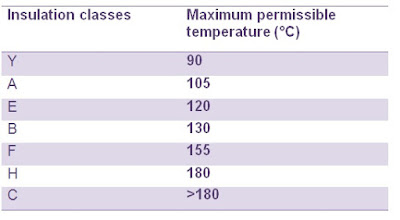Insulation Classes based on the temperature it can sustain is classified into the following classes:
The following are brief explanations of these insulation classes:
Class-Y Insulation:
Class-Y insulations can withstands a temperature of up to 90°C and it is typically made of cotton, silk, or paper.
Class-A Insulation:
Class-A insulations can withstands a temperature of up to 105°C. It is made of reinforced Class-Y materials with impregnated varnish or insulation oil.
Class-E Insulation:
Class-E insulations can withstands a temperature of up to 120°C.
Class-B Insulation:
Class-B insulations can withstands a temperature of up to 130°C. This has a form that inorganic material is hardened with adhesives. This is the first insulator using this structure.
Class-F Insulation:
Class-F insulation can withstands a temperature of up to 155°C; for example, made of Class-B materials that are upgraded with adhesives, silicone, and alkyd-resin varnish of higher thermal endurance.
Class-H Insulation:
Class-H insulations can withstands a temperature of up to 180°C. It is made of inorganic material glued with silicone resin or adhesives of equivalent performance.
Class-C Insulation:
Class-C insulations withstand a temperature of up to 180°C or higher. It is typically made of 100% inorganic material.
As explained above, electrical insulation is classified with its maximum allowable temperature. By adopting an insulation technique of higher thermal endurance, the size of electrical machine can minimized.

Well classified, but why only Class-E insulation materials in use are not mentioned at all?
Nice explanation ,but why Class-y is not given?